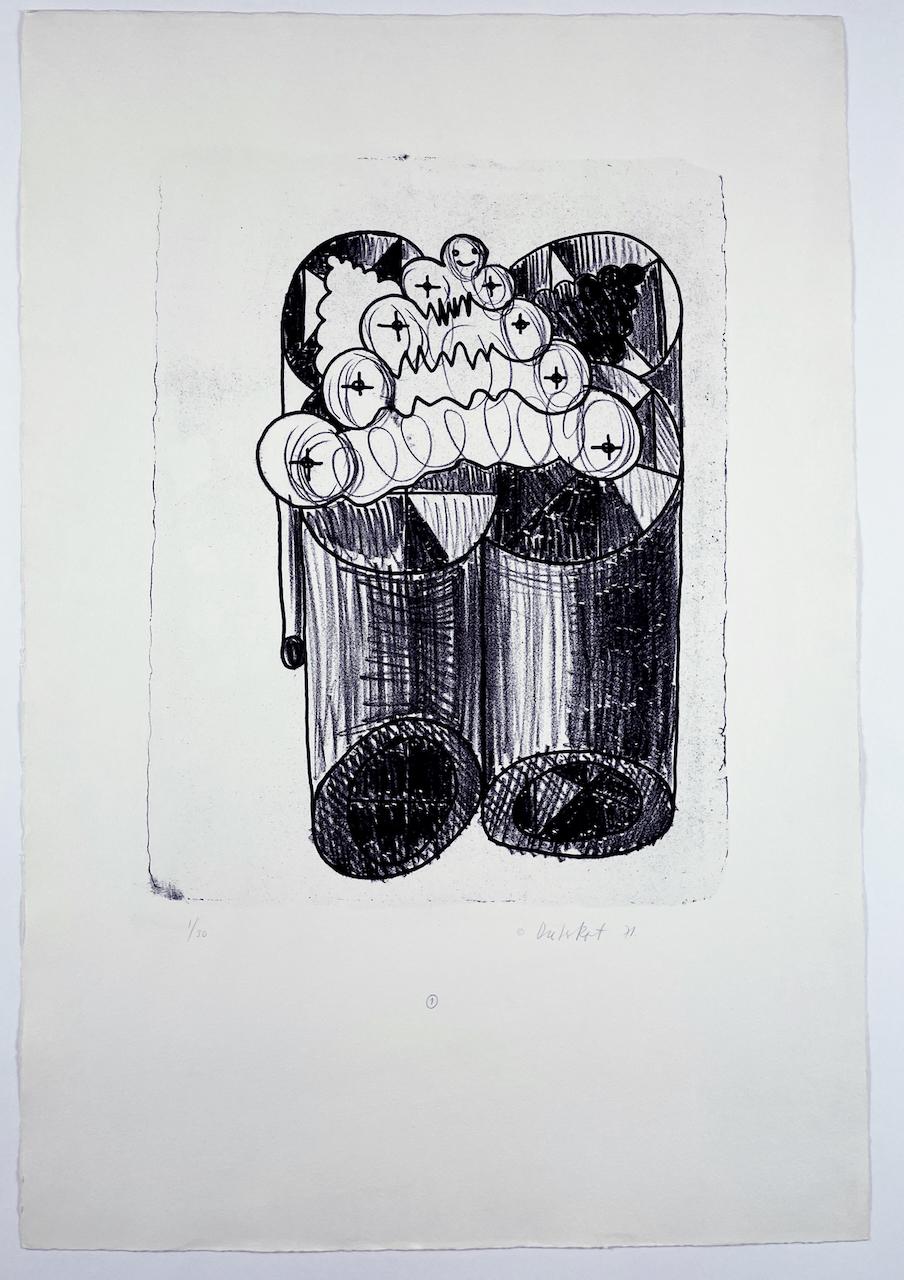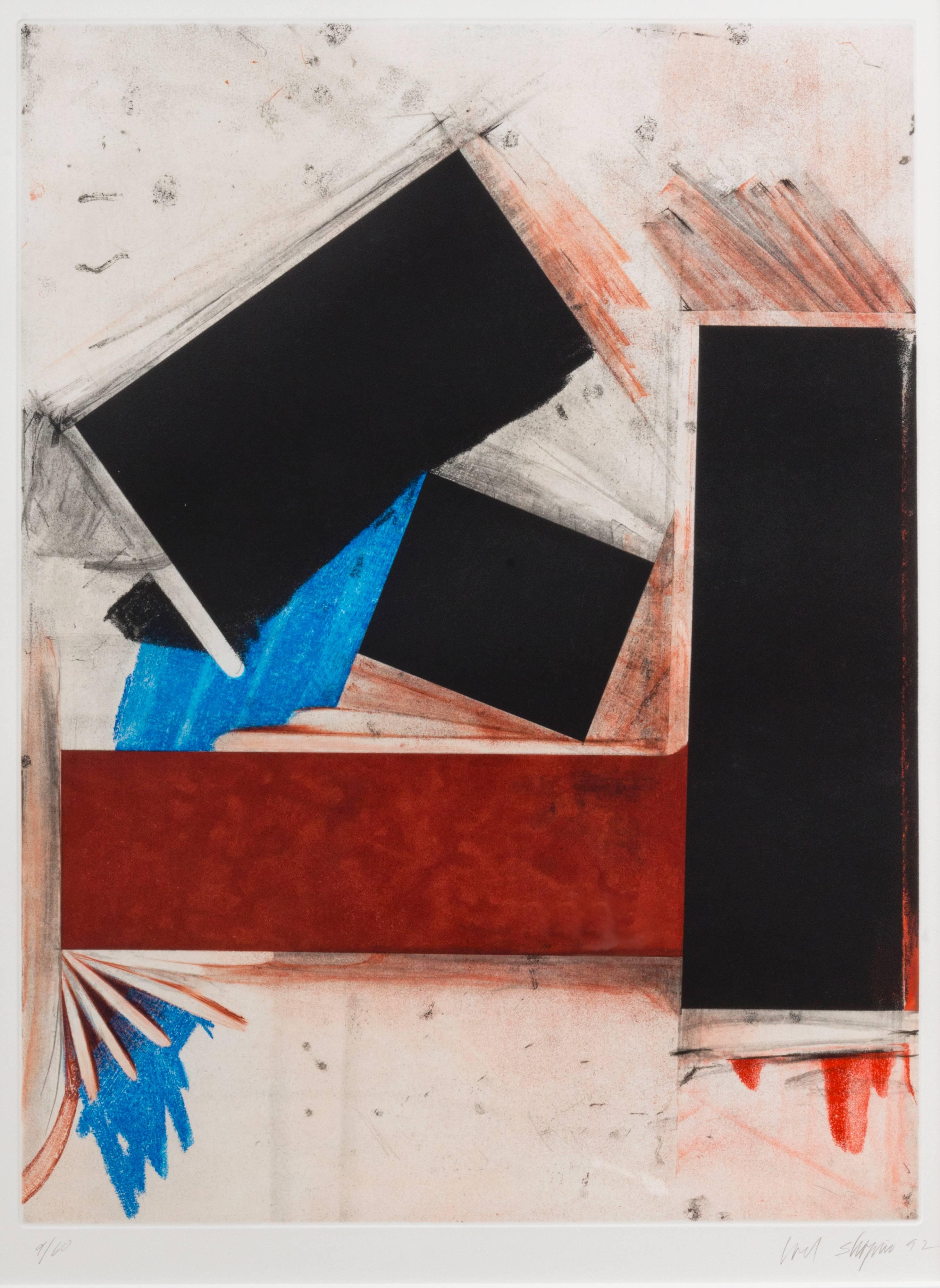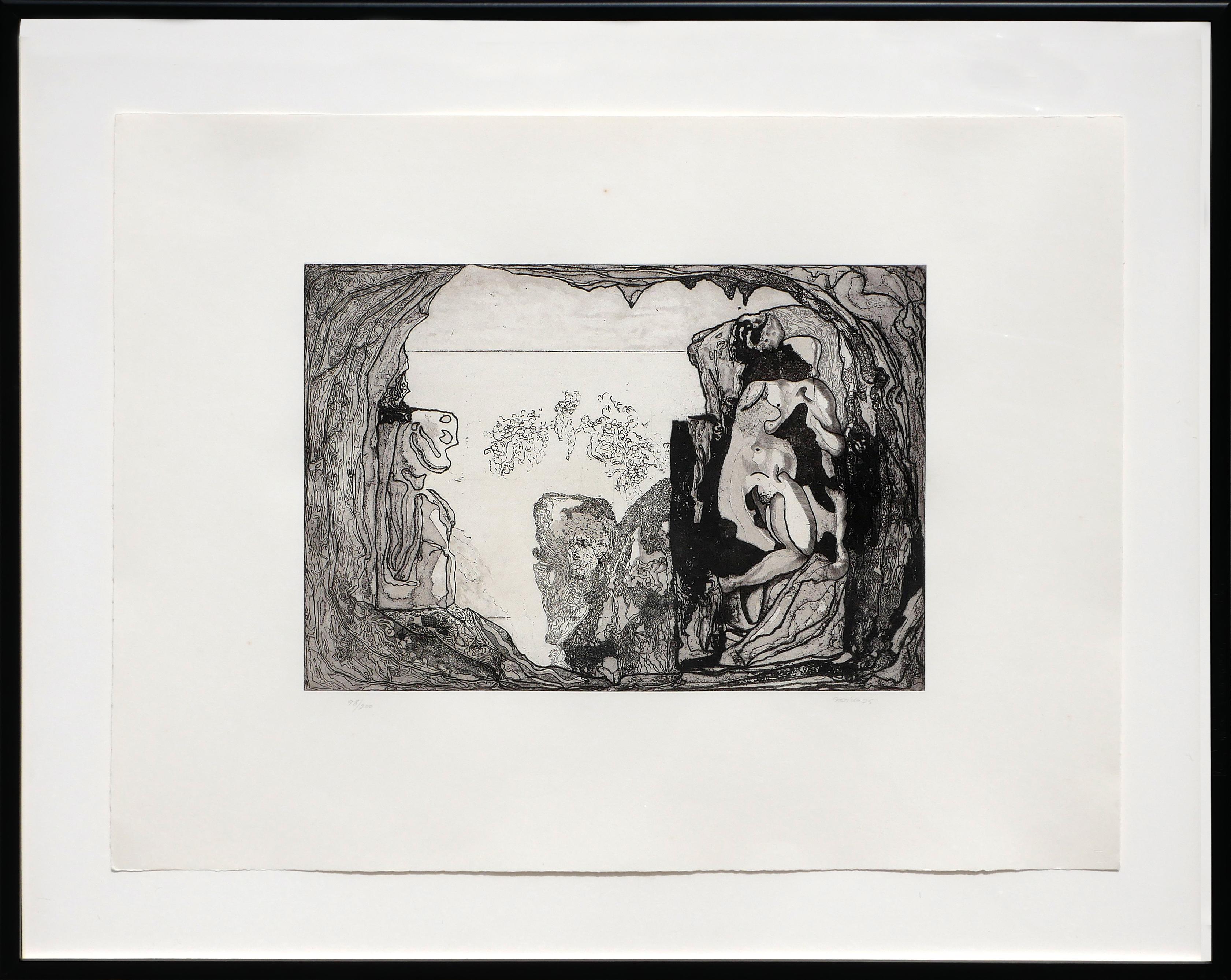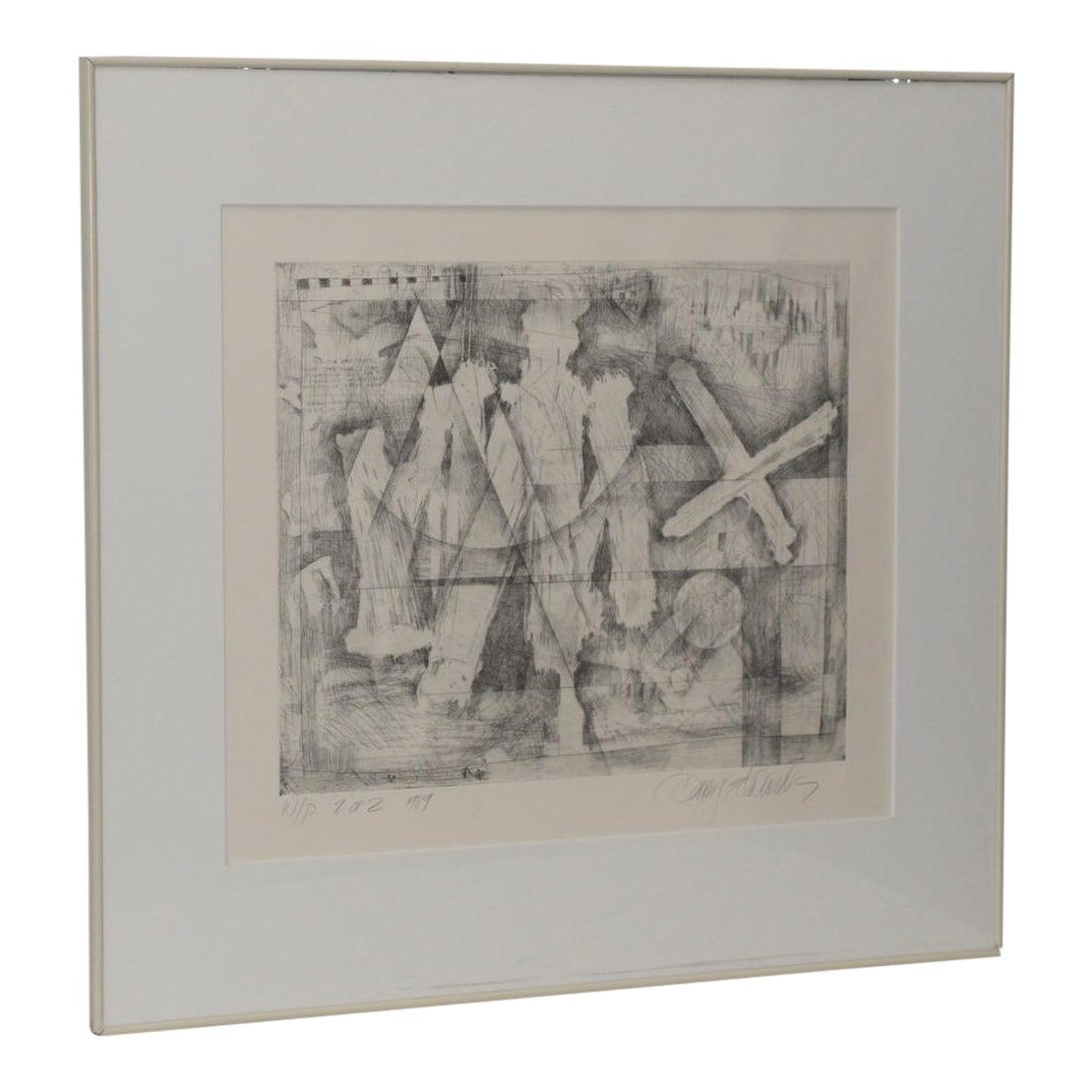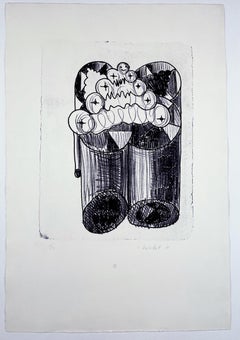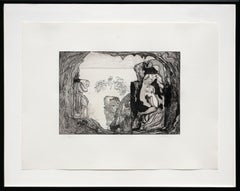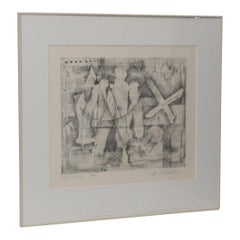Items Similar to A thought by Dieter Roth abstract geometric black and white etching
Want more images or videos?
Request additional images or videos from the seller
1 of 12
Dieter RothA thought by Dieter Roth abstract geometric black and white etching
$1,800
£1,399.04
€1,584.09
CA$2,571.86
A$2,800.15
CHF 1,466.12
MX$33,611.04
NOK 18,503.30
SEK 17,349.99
DKK 11,829.41
About the Item
Sliced sausage, a fork and knife, a cutting board, and a cow mid-slurp comprise this elegant yet tongue-in-cheek black and white Dieter Roth etching. Dieter Roth has long represented food in his work (even using food as a material, as in ''Literaturwurst,'' an artist book which consisted of various periodicals chopped up, mixed with lard and spices and stuffed into a sausage casing.)
A Thought 1971
Plate 11.6 x 9.6 in. / 29.5 x 24.5 cm / Paper 27 x 20.9 in. / 69 x 53 cm
Intaglio printing (etching and drypoint) in dark green on white handmade paper. Edition of 20 with 6 AP. This copy a signed proof. Printed by Karl Schulz, Braunschweig, and published by Petersburg Press, London. (Roth 207)
Condition: Various soft creases throughout upper and lower sheet. Upper corners slightly worn. 1.5” vertical crease upper middle edge. Two 3” creases upper right corner.
Dieter Roth was a printmaker from childhood: his first etching at the age of 16 was scratched into a soda can, and despite the relative failure of the can to print anything but a shadow of ink, he continued his study and by 20 was a serious apprentice in lithography to a well-known commercial artist, Eugen Jordi. Later he would continue to print and publish much of his own work. From the 1960s onward, his collaborations with Petersburg Press brought him international recognition and produced some of his most celebrated work: 6 Piccadillies (1970), and Containers (1972).
Interested in chance and spontaneity, Roth was drawn to make prints using unorthodox means: according to mathematical principles, using equations, or by randomly rearranging blocks before they were run through the press. The artist often printed plates repeatedly in different colors, producing many variations from just a few images. He used the printing press and materials to interrogate the creative process rather than just as tools to achieve an edition of identical prints: for example, overprinting or under-inking, or running objects through the press (in 1968, a box of chocolates). Roth was not just interested in the chance of making pictures but the unpredictability of decay: allowing the grease from slices of meat to slowly contaminate paper, immersing a print in vegetable juice, clamping metal to paper to produce rust, and pouring chocolate over a finished work.
Roth would make hundreds of print editions and books over his career and blurred the line between genres and mediums, embarking on prodigious collaborations and experimentation with music, poetry, art, and literary works.
- Creator:Dieter Roth (1930-1998, German)
- Dimensions:Height: 27 in (68.58 cm)Width: 20.9 in (53.09 cm)
- Medium:
- Movement & Style:
- Period:
- Condition:Various soft creases throughout upper and lower sheet. Upper corners slightly worn. 1.5” vertical crease upper middle edge. Two 3” creases upper right corner.
- Gallery Location:New York, NY
- Reference Number:1stDibs: LU1211215764462
About the Seller
5.0
Recognized Seller
These prestigious sellers are industry leaders and represent the highest echelon for item quality and design.
Gold Seller
Premium sellers maintaining a 4.3+ rating and 24-hour response times
Established in 1968
1stDibs seller since 2019
328 sales on 1stDibs
Typical response time: 2 hours
- ShippingRetrieving quote...Shipping from: New York, NY
- Return Policy
More From This Seller
View AllA feminine thought Dieter Roth portfolio abstract geometric black white etching
By Dieter Roth
Located in New York, NY
A Feminine Thought (portfolio), 1971
Plate 11.6 x 9.6 in. / 29.5 x 24.5 cm
Paper 27.2 x 20.9 in. / 69 x 53 cm
2 prints in portfolio with label, intaglio printing (drypoint) in dark g...
Category
1970s Abstract Abstract Prints
Materials
Drypoint, Etching
A Muse by Dieter Roth set of ten abstract black and white lithographs
By Dieter Roth
Located in New York, NY
This series of abstract black and white Roth prints is full of movement, wildly diverse mark making, visceral, three-dimensional shapes and dynamic sketched lines. The artist worked on the same stone, erasing and adding elements with each step of the process to create a new print. Working on a lithography stone allowed him to scratch away areas with precision, revealing tightly hatched white lines that complement swaths of smokey gray. A Muse reflects Roth’s interest in permutations, decay, and a mathematical approach to making images. Each week the artist created a new variant: the series was originally planned as a set of 52.
Dieter Roth, A Muse 1971-1972
series of 12 prints (this set is an incomplete set of ten prints), lithographs from stone printed in black on white handmade paper
image 18.9 × 14.6 in / 48 x 37 cm paper 30.7 × 20.9 in / 78 x 53 cm
edition of 30 each, numbered and signed, 6 artists copies
this series 1/30
printed by Karl Schulz, Braunschweig and published by Petersburg Press, London
weekly variant printed from the same stone, began October 1971
(52 prints were planned, but only 12 were executed)
Condition: excellent with some dimples and wear commensurate with age
Catalogue Reference: Roth 185-196
Dieter Roth was a printmaker from childhood: his first etching at the age of 16 was scratched into a soda can, and despite the failure of the can to print anything but a shadow of ink, he continued his study and by 20 was a serious apprentice in lithography to a well-known commercial artist, Eugen Jordi. Later he would continue to print and publish much of his own work. From the 1960s onward, his collaborations with Petersburg Press brought him international recognition and produced some of his most celebrated work: Six Piccadillies (1970), and Containers (1972).
Interested in chance and spontaneity, Roth was drawn to make prints using unorthodox means: according to mathematical principles, using equations, or by randomly rearranging blocks before they were run through the press. The artist often printed plates repeatedly in different colors, producing many variations from just a few images. He used the printing press and materials to interrogate the creative process rather than just as tools to achieve an edition of identical prints: for example, overprinting or under-inking, or running objects through the press (in 1968, a box of chocolates). Roth was not just interested in the chance of making pictures but the unpredictability of decay: allowing the grease from slices of meat to slowly contaminate paper, immersing a print in vegetable juice, clamping metal to paper to produce rust, and pouring chocolate over a finished work.
Roth would make hundreds of print editions and books over his career and blurred the line between genres and mediums, embarking on prodigious collaborations and experimentation with music, poetry...
Category
1970s Abstract Abstract Prints
Materials
Lithograph
Untitled by Bruce Nauman abstract black and white drypoint etching 70s
By Bruce Nauman
Located in New York, NY
A moody, evocative black and white abstract etching by pioneer Bruce Nauman.
Bruce Nauman (born December 6, 1941) is an American artist. His practice spans a broad range of media inc...
Category
1970s Abstract Abstract Prints
Materials
Drypoint, Aquatint
Ritual Mark Tobey abstract black tan and white lithograph
By Mark Tobey
Located in New York, NY
This delicate composition in black and tan features layers of sheer brushwork, inky daubs, and thin lines. Mark Tobey, one of the founders of the American Mystical school of painting...
Category
1970s Abstract Figurative Prints
Materials
Lithograph
Suite of four prints by Henri Goetz abstract colorful geometric surrealism
By Henri Goetz
Located in New York, NY
Set of four abstract, surrealist compositions in rich blue, green, purple, turquoise, grey, navy and black.
Henri Goetz
Suite of four etchings with carborundum on Arches wove paper...
Category
1970s Surrealist Abstract Prints
Materials
Etching
Selfportrait as a Flowerpot by Dieter Roth abstract lithograph
By Dieter Roth
Located in New York, NY
This proof is one of just a few printed in this color combination: the edition of 110 is printed with an orange background, while this copy is a muted yellow with the central, scribb...
Category
1970s Abstract Abstract Prints
Materials
Handmade Paper, Lithograph
You May Also Like
Joel Shapiro, Untitled, abstract geometric limited edition etching, 1992
By Joel Shapiro
Located in New York, NY
Joel Shapiro's post-minimalist work often references the human body, in a variety of poses, represented by geometric forms. In Untitled, 1992, a rust-red rectangle supports three black rectangles piled at varying angles. The forms have light, sketchy lines around them, reminiscent of Futurist dynamism markings or perhaps a draftsman's study of dimensions. A gelatinous blue form intersects the balanced rectangles, while further blue forms tumble out of a fanned series of black triangles. Shapiro has assembled mechanism, geometry, balance, fluid, solid and motion into this dynamic etching, which was published by Pace Prints...
Category
1990s Abstract Abstract Prints
Materials
Etching, Aquatint
Black and White Abstract Figurative Etching Edition 98/200
By Jorge Castillo
Located in Houston, TX
Monochromatic abstract figurative etching by Spanish painter Jorge Castillo. The piece depicts an abstract landscape overlooking an empty view from what appears to be a cave. Figures...
Category
1970s Abstract Abstract Prints
Materials
Etching
Danny Edwards Abstract Black & White Etching C.1989
Located in San Francisco, CA
Danny Edwards Abstract Black & White Etching c.1989
Fine abstract etching by Danny Edwards.
Pencil signed and numbered 2/2 by the artist.
Plate dimensions 23.5 x 20. The frame mea...
Category
1980s Abstract Abstract Prints
Materials
Etching
Drypoint Lambda I
By Ron Davis
Located in San Francisco, CA
This artwork titled "Drypoint Lambda I" 1980 is an original etching by noted American artist Ronald Davis, b.1937. It is hand signed, dated and numbered 9/25 in pencil by the artist....
Category
Late 20th Century Abstract Geometric Abstract Prints
Materials
Drypoint, Etching
Drypoint Lambda II
By Ron Davis
Located in San Francisco, CA
This artwork titled "Drypoint Lambda II" 1980 is an original etching by noted American artist Ronald Davis, b.1937. It is hand signed, dated and numbered 9/25 in pencil by the artist...
Category
Late 20th Century Abstract Geometric Abstract Prints
Materials
Drypoint, Etching
Composition - Original Etching by Gian Paolo Berto - 1975
Located in Roma, IT
Composition of Figures is an original etching and drypoint print on paper realized by Gian Paolo Berto, in 1975.
Good conditions except for a small damaged part of the whitish frame...
Category
1970s Contemporary Abstract Prints
Materials
Etching
More Ways To Browse
Chocolate Box
Vintage Meat Slicers
Roth Etching
Rrose Selavy
Salvador Dali Tristan And Isolde
San Lazaro
Shoichi Hasegawa
Space Invader Print
The Paris Review Print
Tim Walker
Victor Vasarely Vega
Victor Vasarely Zebra
Vintage Band Flyers
Vintage Travel Posters Book
Voyage Around The World Litho
Welcome Mat
Ace Gallery Poster
Alan Cote
